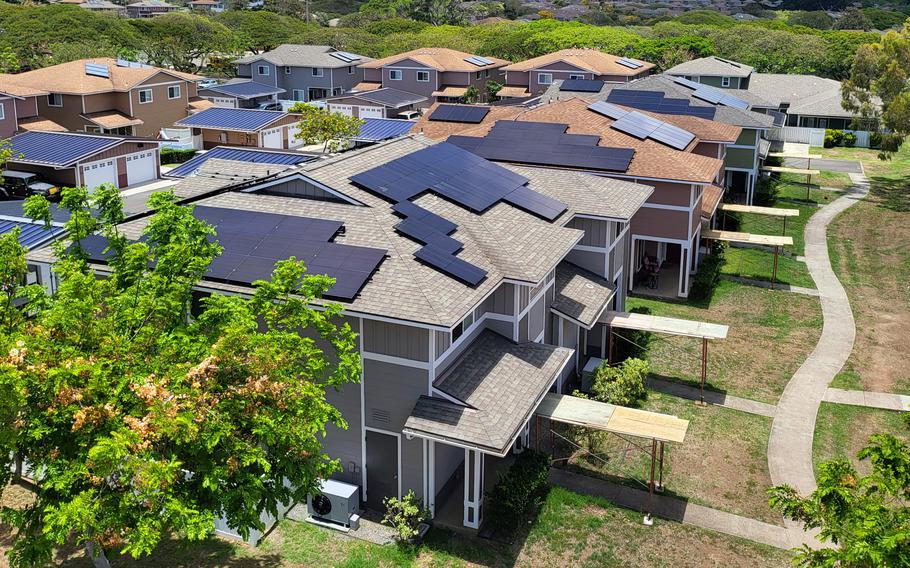
For the past eight months, these six homes in Aliamanu Military Reservation on Oahu, Hawaii, have been clustered for a solar power storage and distribution pilot program that is expected to be taken island-wide. (Lendlease Communities)
The real estate company that manages thousands of homes for the U.S. Army on Oahu is set to expand a pilot program that will reduce demand and dependence on the island’s electrical grid.
Lendlease Communities, which operates almost 8,000 homes on Oahu under a partnership between the Army and Island Palm Communities, has spent the past eight months analyzing a group of six homes clustered to share battery-stored solar power.
Early last year, the company installed roof-top solar panels and storage batteries on six adjacent homes in the Aliamanu Military Reservation on the outskirts of Honolulu, Matt Lynn, senior vice president of energy and utilities for Lendlease, said in a phone interview Wednesday. The homes remain connected to the grid.
“I think what makes this project unique is that the homes are connected in clusters so they can share energy between the homes wherever it's needed most,” he said. “This is a pretty unique structure that really allows the systems to be sized very efficiently and all the power generated essentially is used within the cluster of homes.”
A typical single home with solar and storage normally uses little electricity during the middle of the day, resulting in a filled battery and nowhere for further solar power to be stored, Lynn said.
“So, it just has to go back to the grid or get wasted with this system,” he said. “Because of the clustering, we’re able to actually use every bit of energy that the solar is generating and deliver it to where it’s needed most within the cluster.”
A state ideal for solar
Island Palm Communities manages homes on Schofield Barracks, Wheeler Army Air Field, Fort Shafter, Tripler Army Medical Center, Helemano Military Reservation and Red Hill, but Aliamanu offered the best environment to pilot the cluster concept, Lynn said.
“They are in an area where the solar resource is really good,” he said, comparing it to the generally cloudier conditions found about 15 miles to the northwest at Schofield.
Homes at Aliamanu are also nicely clustered and configured for such a pilot, Lynn said.
Hawaii is an ideal location for both testing and implementing innovations in solar power because of its reliable sunshine and consistently high costs for electricity.
The state is working toward transitioning its energy generation to 100% renewable sources by 2045.
The motivation for the switch is strong, in that Hawaii’s electricity prices are roughly three times the U.S. national average, according to the U.S. Energy Information Administration.
In September, Hawaiian Electric Co., which supplies most of the state’s power, ended the use of its last coal-fired power plant and forecasted an average increase of 7% for individual electric bills.
The Army has been contending with an aged electrical grid at Schofield and Wheeler, which has resulted in routine unscheduled outages in recent years.
Scaling up
Reducing dependence on the electrical grid by hundreds, perhaps even thousands, of Lendlease homes on Oahu will contribute to stabilizing the system, Lynn said.
The Aliamanu cluster has been operational since May.
“So we've been studying it for almost eight months, and we now feel like we're ready to scale this up,” he said. “We are looking to, in the very near future, scale this up to a significant number of homes. Hundreds and ultimately thousands of homes would have this over time. That’s not going to happen overnight. It takes, a while to get the systems, get them installed, but we would move as quickly as we can to get this deployed across a significant number of our homes in Hawaii.”
Residents of Island Palm Communities will benefit indirectly from widespread solar clustering because they are not billed for electricity. In 2019, the Army suspended an energy conservation program for these homes in which residents were billed for above-average consumption and given rebates for below-average use.
But Lynn argues that the project offers “tremendous benefits.”
“We’re providing backup power to our residents so if there's a power outage, they essentially are not impacted by that,” he said. “These systems can help to stabilize the electrical grid on the island by lowering demand on the grid to help avoid power outages in the future.”
For Lendlease it equates to paying less per kilowatt-hour.
“These systems provide the power to us much more cost effectively,” Lynn said. “But I want to make clear that that's not money that goes into our pocket. That's money that gets reinvested back into the project to do upgrades to continue to improve the quality of life of our military families.”